Something completely different today . . .
. . . another from my stock pile, taken 49 years ago on b&w film and now colourised (colorized?) with a spoonful of digital magic to emulate an experiment I attempted at the time with a bleach & toner chemical pack marketed under the name Colourform by Johnsons of Hendon, which involved bleaching the silver image and staining it with a choice of dyes in primary or secondary colours.
I wanted to see if I could produce a full colour effect by masking and dyeing various areas with different colours, but it was a messy and time-consuming job, taking several hours and producing muddy results, so the idea had to be abandoned!
Today - half century later - it took me less than five minutes to work out how to do the job with the free on-line digital photo-editor iPiccy.com, so Hooray for digital processing!
In case anybody else is silly enough to want to try it, I used the 'rainbow' filter which, if applied on its own as a typical quick fix, splashes random colour over random areas of the image, but allowing user control of colour rotation, tone, strength, etc., to produce an individual interpretation with chosen colours in the desired places.
Today's result reminds me of other short-lived colour processes seen at about the same time, including Cinecolor, a muted Hollywood alternative to gaudy Technicolor, and also some of the early duotones and their derivatives seen in the rotogravure magazines of the era, although the techniques and processes for each were completely different again.
It's fun to experiment, and so much easier now to discover new alternatives to the cliché gimmicks, filters and templates loved by some and despised by others in this digital push-button and slider dominated age.
The original photo, taken in Kew Gardens, London, was published as a full page in The Times Educational Supplement in 1967, a few years before run-of-press colour became possible. Today's image was taken from a photograph of the page in my scrapbook, and has survived surprisingly well its journey from film to bromide print, photo-mechanical halftone etched plate, moulding in hot metal and printing in black sticky ink on absorbent newsprint, before being subjected to the prestidigitation described here.
It's easier today, but not half as much fun!
- 14
- 3

Comments
Sign in or get an account to comment.


